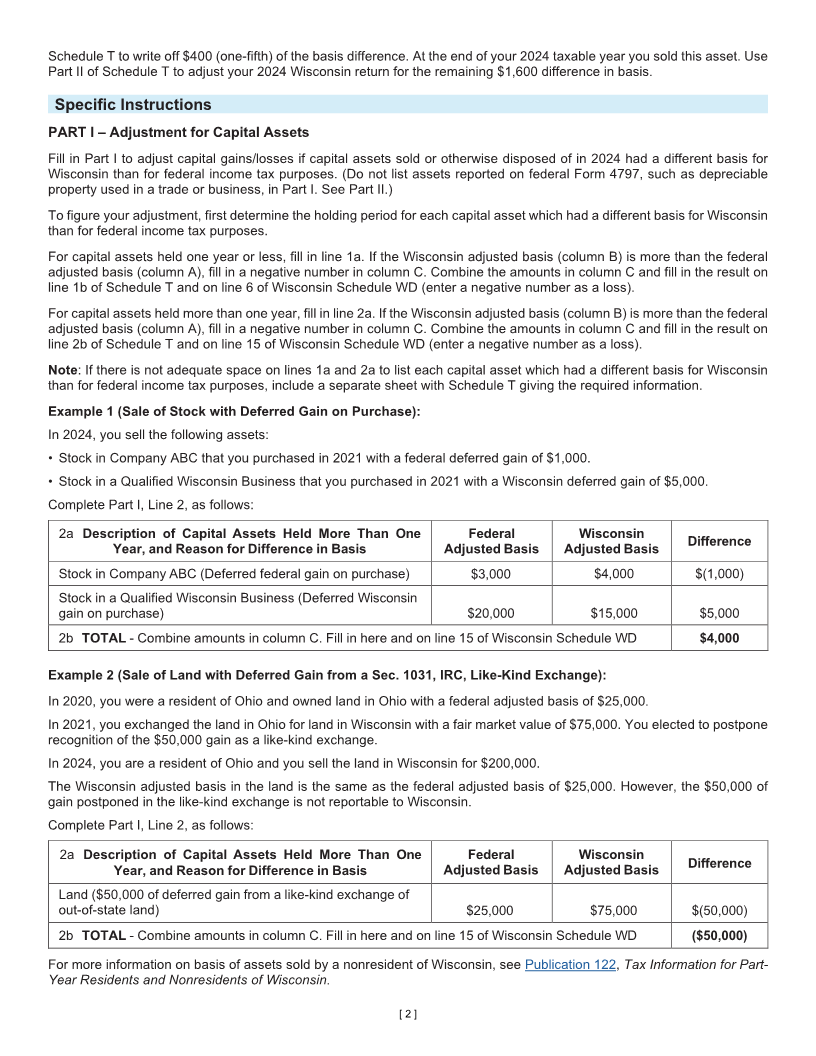
Enlarge image
Instructions for 2024 Schedule T
Who must file Schedule T
Complete Schedule T if:
• You sell or otherwise dispose of an asset that has a different basis for Wisconsin than for federal income tax purposes;
or
• You claim depreciation or amortization on an asset that has a different basis for Wisconsin than for federal income tax
purposes at the time the property is acquired.
Exception: Do not complete Schedule T:
• If the difference in federal and Wisconsin basis is due to Wisconsin’s definition of the Internal Revenue Code (use
Schedule I instead), or to a different federal election used for federal versus Wisconsin tax purposes (redo federal return
using election chosen for Wisconsin or use Schedule I).
General Instructions
An asset may be either constant basis or changing basis.
Constant Basis Assets Constant basis assets are assets, other than inventories, which are not subject to depreciation,
depletion, or amortization, and which do not affect the computation of taxable income until you sell or otherwise dispose of
them. Examples include land, stocks, and bonds.
Account for any difference between the Wisconsin basis and the federal basis of a constant basis asset only when you sell
or otherwise dispose of the asset and recognize gain or loss on the transaction. Use Part I or Part II of Schedule T.
An adjustment for difference in basis generally applies to:
• Constant basis assets which you owned on December 31, 1964 (or, if you filed on a fiscal year basis, on the last day of
your 1964 fiscal year).
• Property acquired by inheritance, the value of which was different for Wisconsin inheritance tax purposes than for
federal estate tax purposes. This applies to property received as a result of deaths before January 1, 1992.
• Stock you owned of a tax-option (S) corporation.
• An investment in a qualified new business venture or qualified Wisconsin business (QWIB), the Wisconsin basis of
which was reduced by deferred long-term capital gain realized on or after January 1, 2011.
For a person who is a nonresident of Wisconsin at the time of disposition of a constant basis asset, an adjustment is required
only if the asset is located in Wisconsin.
Example: In 2024, you sold a vacant lot located in Wisconsin. You purchased the lot in 1960 for $1,000 and never received
income from use of the lot. As required under prior Wisconsin law, you capitalized the taxes paid on the lot. From 1960
through 1964, you paid a total of $300 of real estate taxes on this lot. Your Wisconsin basis when you sold it was $1,300
($1,000 plus $300). For federal purposes you were allowed to deduct the real estate taxes and, therefore, your federal basis
was $1,000, the original cost. Use Part I of Schedule T to adjust your 2024 Wisconsin return to account for the $300
difference in basis.
Changing Basis Assets Changing basis assets are inventories and assets or accounts, including liability and reserve
accounts created by accruals or other charges deducted from income, other than annuities. Examples:
• Tangible property subject to depreciation, depletion, or amortization; intangible property subject to amortization of cost,
premium, or discount.
• Capitalized intangible expenses such as trademark, research and development, and loan expenses.
• Accruals, reserves, and deferrals of income or expense.
Account for any difference between the Wisconsin basis and the federal basis of a changing basis asset acquired on or
after the first day of your taxable year beginning in 2014 by writing off the difference in basis over the life of the asset. Use
Part III of Schedule T. However, if you dispose of the asset before the entire difference in basis has been written off, account
for the remaining difference in the year of disposition. Use Part II of Schedule T.
Example: In 2023, you acquired a depreciable asset you use in your trade or business. The asset has a useful life of 5
years, a Wisconsin basis of $12,000, and a federal basis of $14,000. During the year 2023, you made an adjustment on
I-119 (R. 11-24) Wisconsin Department of Revenue


